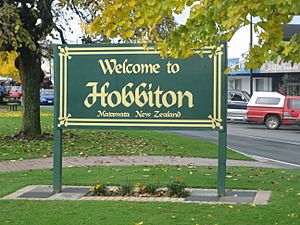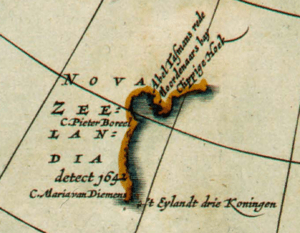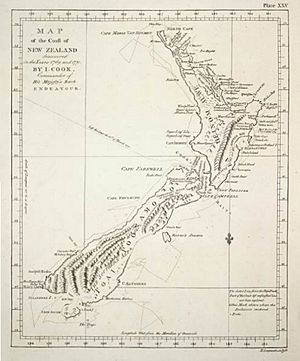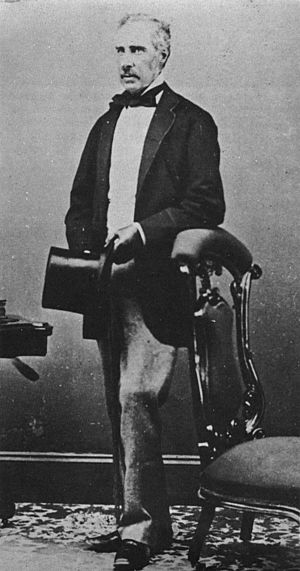New Zealand place names facts for kids
New Zealand's place names mostly come from two main groups: the Māori and the British. Both groups named places to remember important people, events, or places from their home countries. They also named places to describe the land around them.
Before Europeans arrived, we don't know if Māori had one name for all of New Zealand. But after Europeans settled, the name Aotearoa became common for the whole country. This name is often translated as 'long white cloud'.
Dutch mapmakers first called the islands Nova Zeelandia. This was a Latin version of the Dutch name Nieuw Zeeland. It was named after a province in the Netherlands called Zeeland. Later, when British explorers arrived, the name became New Zealand.
Many early Māori names were changed by Europeans in the late 1700s and early 1800s. But later, rules were made to encourage using original Māori names. The New Zealand Geographic Board was set up to help with this. Today, many places have both English and Māori names, or sometimes even two Māori names.
How New Zealand Got Its Name
Before Europeans arrived, Māori didn't have one name for all of New Zealand. But they did have names for the North and South Islands. The North Island was called Te Ika-a-Māui, meaning 'the fish of Māui'. The South Island had names like Te Waipounamu, meaning 'the waters of greenstone', and Te Waka o Aoraki, meaning 'the canoe of Aoraki'.
Until the early 1900s, Māori also called the North Island Aotearoa. This name means 'long white cloud'. Now, Aotearoa is used for the whole country.
First European Names
The first European to see New Zealand was Dutch explorer Abel Tasman in 1642. He named it Staten Land to honor the Dutch parliament. He thought it might be connected to a landmass in South America.
But in 1643, another explorer proved the South American land was an island. So, Dutch mapmakers renamed Tasman's discovery Nova Zeelandia. This Latin name came from the Dutch province of Zeeland. Later, it became Nieuw Zeeland in Dutch.
We don't know exactly when it became New Zealand in English. But when British explorer James Cook sailed in 1768, his orders already called the land New Zeland.
Naming the Main Islands
In 1840, New Zealand officially became a British colony. The British claimed the "principal islands" and called them the Northern Island, the Middle Island, and Stewart's Island. They tried to rename them New Ulster, New Munster, and New Leinster after places in Ireland. These names were also used for early provinces, but they didn't stick.
By 1907, the Middle Island became commonly known as the South Island. The names North Island and South Island became popular through everyday use. It was only in 2009 that people realized these names had never been officially declared!
In 2013, the two main islands finally got official alternative names. They are now known as North Island or Te Ika-a-Māui, and South Island or Te Waipounamu. You can use either the English or Māori name, or both together.
Māori Place Names
Many Māori place names have important historical or mythological meanings. Their meanings aren't always clear from just translating the words. But some meanings have been passed down through stories.
Before Europeans arrived, Māori often named places to remember important events. They also described features of the land. Some names came from traditional places in Hawaiki or from myths. After Europeans came, some places got names that were Māori versions of European words. Others were poorly pronounced Māori names.
Early Māori Explorers
Early Māori explorers like Kupe, Ngahue, and Toi named many coastal areas. Like European explorers, they named places after themselves or their families. They also named places after things that happened there.
For example, Kahumatamomoe named Manukau Harbour after a manuka stick he used to claim the area. He named Kaipara Harbour after the para fern he ate there. Kai means food.
The Māori name for Wellington Harbour is Te Whanganui a Tara. This means 'the great harbour of Tara'. Tara was a grandson of Kupe.
Some New Zealand landmarks have names from other islands visited during the Polynesian migrations. For example, Raratoka Island comes from Rarotonga. Tawhiti comes from Tahiti.
Places like Whakatāne, Rangitoto Island, Taupō, Urewera, Ngongotahā, and Tikitapu all remember events from early arrivals. Many of these stories are now forgotten.
Maketu and Mount Moehau are two of the few names still linked to places in Hawaiki. Names from Polynesian mythology are more common. For example, Tāne (the forest god) gave his name to Ōtāne and Taneatua.
Descriptive Māori Names
Many Māori place names include descriptive words. Here are some common ones:
- ara (path, road)
- hau (wind)
- maunga (mountain)
- moana (sea, ocean)
- nui (big)
- one (mud, sand, beach)
- puke (hill)
- roto (lake)
- wai (water)
- whanga (bay)
- whenua (land, country)
So, Whanganui means "wide river-mouth". Waikanae means good waters for catching kanae, which are flathead mullet.
New Influences on Māori Names
When Europeans arrived, Māori learned about Christianity. This led to settlements being named after biblical places. For example, Hiruharama is named after Jerusalem. Petane is named after Bethany. Hamaria is named after Samaria.
Other settlements have Māori versions of European city names. Ranana is like London. Atene is like Athens. Karaponia is like California.
The Moriori people, who are descendants of Māori, moved to the Chatham Islands around 1500 CE. They named the islands Rēkohu, meaning 'Misty Sun'. Later, mainland Māori settled there and confused the name of a settlement, Wharekauri, with the main island. So, the main island has been known as Wharekauri to Māori ever since.
Official Recognition of Māori Names
Early Europeans replaced most original Māori names with their own. But they kept some, especially in the North Island. The Royal Geographical Society of London used to be in charge of place names until 1894. Then, the governor of New Zealand took over.
In 1894, a rule was made to prefer Māori names for new places. It also allowed correcting misspelled names. In 1946, the New Zealand Geographic Board (NZGB) was created. It has the power to change or create Māori and English names.
Anyone can suggest a name to the Board. The Board talks to local Māori groups and asks for public opinions. Then, they decide if a name should be official. Names can also become official through a special law passed by New Zealand Parliament. The NZGB keeps a public list of all official New Zealand place names.
The NZGB encourages using original Māori names. They have given some places official double names. These can be alternative names, where either name can be used. An example is Mount Taranaki or Mount Egmont. Or they can be dual names, where both names should be used together, like Matiu / Somes Island.
In 1998, New Zealand's tallest mountain officially became Aoraki / Mount Cook. This happened as part of a settlement with the Ngāi Tahu Māori group. There are also a few English dual names. For example, Wellington Harbour is also officially known as Port Nicholson.
Māori groups have worked to correct misspelled or mispronounced Māori place names. In 2009, the NZGB suggested changing the city of Wanganui to Whanganui. This was because the town was named after the Whanganui River. The word wanga is not in the Māori language. The government later decided to accept both "Whanganui" and "Wanganui" as official names.
European Place Names
Abel Tasman named a few places along New Zealand's west coast. Some, like Murderers Bay, didn't last. But others, like Cape Maria van Diemen (named after the wife of a governor) and Three Kings Islands, are still used.
Captain Cook named many more places on his voyages. These include Bay of Islands, Bay of Plenty, Poverty Bay, Cape Farewell, Queen Charlotte Sound, Mount Egmont, and Banks Peninsula. Cape Kidnappers remembers a Māori attempt to kidnap one of Cook's crew.
Jules Dumont d'Urville named French Pass after sailing through it. Explorers often gave their names to places. Examples include Mount Tasman, Tasman Glacier, the Tasman Region, Cook Strait, Mount Cook, and d'Urville Island.
Ships that visited New Zealand also gave their names to places. The Coromandel, Chatham, and Pegasus ships visited between 1791 and 1820. They were used to name Coromandel Peninsula, Chatham Islands, Pegasus Bay, and Port Pegasus. Stewart Island was named after the first officer on the Pegasus.
Names from Settlers and Officials
Most European names came between the 1840s and 1910s. Surveyors working for colonizing groups or governments gave these names. They honored the groups' sponsors, like Hutt Valley, Wakefield, Port Chalmers, and Ashburton.
Ships, government officials, politicians, and church leaders also lent their names. Examples include Bombay (a ship), Featherston (an official), Foxton (a politician), and Selwyn (a church leader).
Military heroes and famous battles were popular for place names. This includes Auckland, Napier, Hastings, Havelock, Wellington, Picton, Marlborough, Nelson, and Blenheim.
British politicians and royalty also gave their names to places. These include Russell, Palmerston, Cromwell, Queenstown, and Alexandra. Franz Josef is named after an Austrian emperor.
Royal names are more common for streets than towns. But both Auckland and Wellington have a Mount Victoria. Gore is named after Governor Thomas Gore Browne. George Grey's name is used for Greytown, Greymouth, Grey Lynn, and many natural features.
Few names come directly from British towns. Notable exceptions are Dunedin (from Edinburgh in Scotland), New Plymouth, and the Canterbury Province.
Descriptive and Settler Names
Many inland places were named after early settlers. These include Helensville, Dargaville, Morrinsville, Bulls, Masterton, and Levin. Mackenzie Country is named after a sheep stealer. King Country refers to the area where the Māori king lived without colonial government rule for many years.
Mountains and passes were named after their discoverers. Examples are Haast and Lewis Pass. Some were named after scientists, like Newton and Lyell.
Other names were descriptive. These include Woodville, Island Bay, Riverton, Whitecliffs, and Bluff. A few names come from other languages. Miramar means "sea view" in Spanish. Inchbonnie means "beautiful island" in Scottish Gaelic.
Regional Naming Patterns
Many Scottish names are found in Otago and Southland. Examples include the Lammerlaws, Invercargill, Wedderburn, and Glenfalloch. Scottish settlers also named Riccarton and the Avon River in Christchurch.
Canterbury has many English names, like Christchurch and Oxford. But it also has Belfast and French names around the Akaroa area. Scandinavian migrants left their mark in the Seventy Mile Bush with Dannevirke and Norsewood. Some suburbs in Auckland and Wellington reflect Australian immigration, like Botany Downs.
There are very few Asian influences in New Zealand place names. Khandallah in Wellington and Cashmere (from Kashmir) in Christchurch reflect British connections to India, not direct Indian influence.
Unofficial Place Names
Many of New Zealand's place names have never been officially approved by the NZGB. They might be places outside the board's control, like homesteads. Or they were common names before the board existed and were never made official.
Unofficial names are called "recorded names" if they appear in at least two trusted publications. These include major cities like Wellington, Auckland, Hamilton, and Christchurch. They also include mountains like Mount Tasman and islands like Auckland Islands.
Nicknames for New Zealand
New Zealand and its parts have gained many nicknames over the years. In the late 1800s, unofficial names for New Zealand included "Maoriland" and "God's Own Country". The first was popular in the labor movement. The second was made popular by Prime Minister Richard John Seddon. Both names became less popular in the 1900s. But "God's Own Country" (or "Godzone") still appears sometimes.
Latin names for the country have included Zealandia and Nova Zealandia.
City Nicknames
Many cities and towns have nicknames. These are often based on a special feature or something promoters want to highlight. Christchurch is known as the "Garden City." Auckland is often called the "city of sails." Hamilton got the nickname "the Tron" from a city slogan, "Hamiltron: City of the Future." Wellington is known as the "windy city" because of its strong winds.

After Peter Jackson's The Lord of the Rings films came out, New Zealand was sometimes called "Middle-earth." This is the fictional world from the movies. Wellington, where the films were made, was also sometimes called Middle-earth. For about a week, a local newspaper even renamed itself The Middle Earth Post.
The town of Matamata, where many Hobbiton scenes were filmed, unofficially renamed itself "Hobbiton." The growing film industry in Wellington led to the nickname "Wellywood." There was even a plan for a "Hollywood" style sign near the airport, but it was stopped.
Some towns have ironic nicknames comparing them to Las Vegas. These include "Rotovegas" for Rotorua, "Ashvegas" for Ashburton, and "Invervegas" for Invercargill.
Other areas have nicknames that are shortened or changed versions of their Māori names. New Zealanders might call the Taranaki Region "The Naki." Palmerston North is "Palmy." Gisborne is "Gizzie." Cardrona is "Cardie." Paraparaumu is "Paraparam." Waimakariri is "Waimak." Paekakariki is "Pie-cock."
Waikikamukau is a funny, made-up name for a small rural town in New Zealand. It sounds like "Why kick a moo-cow."




